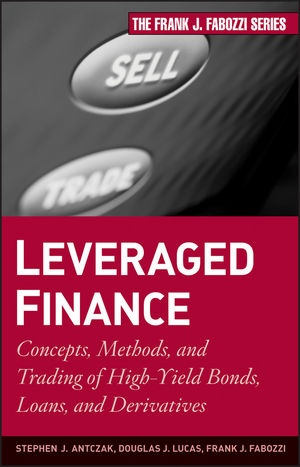Leveraged Finance: Concepts, Methods, and Trading of High-Yield Bonds, Loans, and DerivativesISBN: 978-0-470-50370-6
Hardcover
368 pages
July 2009
 This is a Print-on-Demand title. It will be printed specifically to fill your order. Please allow an additional 10-15 days delivery time. The book is not returnable.
|
||||||
About the Authors.
Chapter 1: Introduction.
Part One: The Cash Market.
Part Two: The Structured Markets.
Part Three: The Synthetic Markets.
Part Four: How to Trade the Leveraged Finance Market.
Part Five: Default Correlation.
Part One: The Cash Market.
Chapter 2: The High-Yield Bond Market.
The Reasons Companies Are Classified as High-Yield Issuers.
Size and Growth of the Cash Market.
Types of Structures.
A Look at Ratings.
Risk and Return for Bonds.
What's Priced In?
How About Recoveries?
Summary.
Chapter 3: Leveraged Loans.
A Tale of Two Loans.
Introduction to Leveraged Loans.
An Overview of Loan Terms.
Loan Recovery Rates.
Loan Default Rates.
Summary.
Part Two: Structured Market.
Chapter 4: Collateralized Loan Obligations.
Understanding CLOs.
Elaborations and Details.
Summary.
Chapter 5: CLO Returns.
Default and Recovery Scenarios.
Distressed Loan Prices, Overflowing Triple-C Buckets, and CLO Returns.
Summary.
Chapter 6: CLO Portfolio Overlap.
Collateral Overlap in U.S. CLOs.
Collateral Vintage vs. Deal Vintage.
Favorite CLO Credits.
Single-Name Risk and Tranche Protections.
Excess Over-Collateralization and Excess Over-Collateralization Delta.
Senior and Subordinate Excess OC Deltas.
Equity Tranches and Distressed Tranches.
Summary.
Part Three: Synthetic Markets.
Chapter 7: Credit Default Swaps and the Indices.
What Are Credit Default Swaps?
Who Uses Protection, and for What?
Growth of the Market.
Marking-Market: SDV01.
Credit Default Swaps Indices.
Contrasting the LCDX and CDX Indices.
Beta: A Study of Movement..
Summary.
Chapter 8: Index Tranches.
Basic Mechanics of the Tranche Market.
Loan Tranches.
Summary.
Part Four: How to Trade the Leveraged Finance Market.
Chapter 9: Recessions and Returns.
Broad Market Performance.
Sector Performance.
Performance by Rating.
Summary.
Chapter 10: Framework for the Credit Analysis of Corporate Debt.
Approaches to Credit Analysis.
Industry Considerations.
Financial Analysis.
Quantitative Models.
Summary.
Chapter11: Trading the Basis.
The Basic Basis Package.
Constructing the Basic Package.
Moving Away from the Basic Model.
Adding Positive Convexity.
Negative Convexity.
A More Complex Basis Package.
Hedge Ratios for CLO Hedging.
Summary.
Chapter12: How Much Should You Get Paid to Take Risk?
Single Name Credit Risk.
Curve Risk.
Basis Risk.
Capital Structure Risk.
Summary.
Part Five: Default Correlation.
Chapter 13: Default Correlation: The Basics.
Default Correlation Defined.
Default Probability and Default Correlation.
Summary.
Chapter 14: Empirical Default Correlations: Problems and Solutions.
Empirical Results.
Problems with Historical Default Correlations.
Proposed Solutions.
Summary.
Index.



